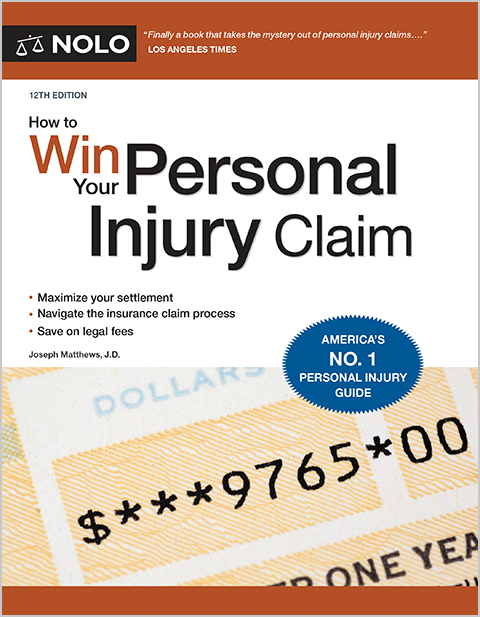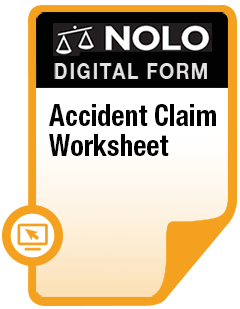Injured in a Connecticut slip and fall? Find out about the elements of a slip and fall claim, defenses the landowner is likely to raise, the lawsuit filing deadline, and more.
You fell on a slippery substance spilled in a grocery store aisle. The fall broke your arm and injured your neck. You're thinking about an insurance claim or a slip and fall lawsuit against the store to recover compensation ("damages") for your injuries. But you're not sure about Connecticut law. What must you prove to win your claim?
Most slip and fall (and trip and fall) cases are grounded in the law of negligence. Negligence is the failure to be as careful as the circumstances require. What does that mean? Generally speaking, it means that landowners have a legal duty to make their property safe for known or foreseeable visitors, or to warn visitors of hazards. But as we'll see, legal duty is a two-way street. Visitors must look out for their own safety, too.
We begin with the elements of a Connecticut slip and fall claim, focusing most of our attention on the issue of fault—who's legally responsible for your injuries. We'll also touch on the lawsuit-filing deadline, defenses the landowner might raise, and more.
The Elements of a Connecticut Slip and Fall Case
To prove a Connecticut slip and fall or trip and fall claim, you must show that:
- the landowner owed you a duty of care
- the landowner breached, or failed to meet, that duty of care
- you suffered an injury, and
- your injury was caused by the landowner's failure to meet the duty of care.
The first two elements—duty of care and breach of that duty—are what the law calls negligence. In a typical slip and fall claim, legal responsibility comes down to whose negligence caused the accident. Most often, you point the finger at the defendant (the party you're suing), and the defendant turns around and points right back at you.
(Learn more about slip and fall claims on government property, at a business, and at a private residence.)
Who Can Be Responsible for a Slip and Fall Claim?
Anyone who owns or controls a property can be on the hook for a slip and fall injury. Landowners, tenants, contractors, property managers, and easement owners, among others—for the sake of convenience, we'll call them all "owners" or "landowners"—must take reasonable care to warn of or eliminate dangerous conditions on their property.
Your lawyer will identify and pursue all potentially responsible parties, provided they have insurance or other assets to cover your damages. In most cases, they'll fight among themselves to figure out who has to pay you.
What Is a Duty of Care?
The duty of care is a legal standard—a rule that explains what a landowner should do to be reasonably sure their property is safe for visitors. It's a way of saying to a landowner: "This is the least you must do to avoid legal responsibility for injuries that happen on your property."
In Connecticut slip and fall cases, a duty of care arises when:
- there's a dangerous condition on the property, and
- the landowner knows (or in some cases, the landowner should know) about the danger.
Relationships Define the Duty of Care
Under Connecticut law, a landowner's duty of care usually depends on the relationship, if any, between the landowner and the visitor. For this purpose, Connecticut recognizes three categories of visitors: Trespassers, invitees, and licensees.
Trespassers. A trespasser is someone who's on a property without permission, or after permission to be there expired or was revoked.
Duty owed to trespassers. As a general rule, Connecticut landowners owe no duty of care to trespassers other than to avoid intentionally causing them harm. There are two exceptions to this no-duty rule. First, when a landowner knows there are trespassers on their land, they must warn of known dangers. But they don't have a duty to inspect for hidden hazards.
Second, Connecticut, like most states, has a special rule for trespassing children. Kids often are drawn to what the law calls an "attractive nuisance," meaning a property with human-made features that children find irresistible. Swimming pools, trampolines, construction equipment, and abandoned vehicles are common examples. When a landowner knows that kids trespass on their land because it presents an attractive nuisance, they must take reasonable steps to make the property safe, warn of the danger, or both.
Invitees. An invitee comes to a property—usually a business or retail property held open to the public—with the owner's express or implied invitation. Connecticut recognizes two categories of invitees.
- Public invitees. When a landowner opens their property to the public for a particular purpose, a public invitee is anyone who's invited to enter the property for that purpose. Suppose a landowner leases space to doctors in a medical building. Patients who come to the building are the landowner's public invitees, because the landowner invites them to enter for that purpose.
- Business invitees. A business invitee is a person who enters the property at the landowner's invitation to do business with the landowner. Store customers, for example, are business invitees of the store owner. Restaurant patrons are business invitees of the restaurant owner. Social guests are invitees and are owed the same duty of care as business invitees. (Conn. Gen. Stat. § 52-557a (2024).)
Duty owed to invitees. When an owner has actual or constructive notice of a dangerous condition that's unknown to an invitee, the landowner must exercise reasonable care for the invitee's safety. Reasonable care requires the landowner to either warn of the condition or fix it.
Constructive notice means the condition was there for a long enough time that the owner should have discovered it, had they made a reasonable effort to inspect their property. Stated a bit differently, landowners also owe invitees a duty of care to inspect their property for hidden dangers. If a hidden danger existed for a long enough time that a reasonable inspection would have revealed it, the landowner will be charged with knowledge of the danger.
A landowner probably isn't responsible for an invitee's injury when the invitee knows of a dangerous condition, either because it's open and obvious (discussed below) or the owner warned of it. But if the landowner knows there's a risk of harm to an invitee even though the danger is obvious, the landowner might still have a duty to act for the invitee's safety.
Licensees. You're a licensee when you come to a property with the owner's permission, but for a purpose that mostly benefits you. For example, a person who hunts or fishes on a property with the landowner's permission is a licensee.
Duty owed to licensees. An owner who has actual knowledge of a dangerous condition that's unknown to a licensee must either warn about the danger or remedy it. Constructive notice isn't enough to impose liability in the case of a licensee. As with invitees, a landowner probably isn't responsible for injuries resulting from known or obvious dangers.
Like many states, Connecticut has special rules for recreational lands and activities. Landowners who make their property available without charge for specified recreational activities aren't liable for accidental injuries. (See Conn. Gen. Stat. § 52-557g (2024); Conn Gen. Stat. § 52-557j (2024).)
Dangerous Conditions and Landowner Notice
To prove that a landowner was negligent, you start by showing there was a dangerous condition on the property. Next, you must show that the landowner knew (or in the case of invitees, knew or should have known) about the danger.
Examples of dangerous conditions. Here are some examples of dangerous property conditions:
- uneven surfaces caused, for example, by something like a crack or break in the pavement or walk
- loose or easily movable surface material such as gravel, rocks, or sand
- wet, slushy, snowy, or icy walkways
- stair runs or risers that are larger or smaller than what's typically required by building or safety codes
- torn, frayed, or unsecured carpets or rugs
- accumulations—natural or artificial—of water, snow, or ice
- foreign substances like liquids, foods, or other slipping or tripping hazards on floors
- aisles or walkways occupied or partially blocked by product displays
- tools or equipment left in aisles or walkways
- products spilled on store aisles
- inadequate lighting
- missing or defective railings, handrails, or guardrails, and
- things hanging from shelves or ceilings.
The landowner knew of the danger. A landowner can't be expected to warn about or fix dangerous conditions when the landowner isn't aware of them. Proving that the landowner had notice of the condition is critical to a slip and fall claim. In most cases, the landowner will deny having had any notice of the danger, or having received notice in sufficient time to take corrective action.
For invitees and licensees, a landowner's actual notice of a dangerous condition will suffice. Unless the landowner created the dangerous condition, proving what they actually knew can be a challenge. Here are examples of the kinds of evidence you might look for.
- Prior incident reports and complaints, documenting earlier encounters with the condition.
- Maintenance records, showing prior efforts to deal with the condition.
- Inspection reports from government agencies, recording prior infractions or safety violations related to the condition.
- Surveillance photos or videos, to prove how the condition came to be and how long it had existed.
- Testimony from others who saw the dangerous condition, to find out what they saw and what, if anything, they reported to the landowner.
- Emails, text messages, and other communications indicating that the dangerous condition was known to the landowner or its agents.
- Testimony from the landowner and the landowner's agents, to find out what they knew about the condition and when they knew it.
- Expert witness testimony, which can help to establish, for example, how long a substance likely had been on the floor before you fell on it.
When an invitee is injured, the landowner's constructive notice of the danger can be enough. You'll need to rely on the landowner's constructive knowledge of a dangerous condition when—as often will be the case—the landowner denies having actually known of it.
The key to constructive notice is proving how long the dangerous condition was there before it injured you. Then, you can argue that had the landowner been reasonably careful, they would have inspected the property, discovered the danger, and fixed it or warned you about it.
(Learn more about proving fault for slip and fall accidents.)
Landowner Defenses: Shifting the Blame to You
In addition to lack of notice, landowners can raise a number of defenses to a slip and fall claim. Three of the most common are:
- you were partly or completely to blame for your injuries
- the danger was open and obvious, and
- you assumed the risk of a known hazard.
You Were to Blame
Your own negligence is a defense to the owner's legal responsibility. If the accident happened in a contributory fault state, any negligence on your part—even 1% of the total—defeats your claim entirely. When the accident happened in a comparative fault state, your share of the negligence reduces the damages you can collect. Some comparative fault states, including Connecticut, bar you from collecting any damages if you're mostly to blame for what happened.
Connecticut is a "modified" comparative negligence state. In Connecticut, you can still collect some damages for your slip and fall injuries even if you were partly to blame, as long as you weren't mostly—51% or more—at fault. Up to that point, your percentage share of the negligence reduces your damages by that amount. But once you're found to have been 51% or more negligent, you can't recover any damages. (Conn. Gen. Stat. § 52-572h(b) (2024).)
What did you do that was negligent? Expect the defendant to search high and low looking for ways to blame you for the fall. Here are a few of the most common claims.
- You were on a part of the property where visitors aren't allowed, or aren't expected to be.
- You weren't paying attention to where you were walking.
- You were distracted by a child, or your phone, or something else.
- You were wearing footwear that was inappropriate or even unsafe for the situation.
- You were warned of the dangerous condition, or the owner took reasonable steps to protect visitors.
- The dangerous condition was open and obvious.
Open and Obvious Dangers
In many states, landowners aren't responsible for injuries caused by open and obvious dangers. An open and obvious danger is a condition that's clearly visible and that should be seen by a reasonable person exercising ordinary care for their own safety. Common examples include accumulations of snow or ice, large objects, and darkness.
In Connecticut, the fact that a dangerous condition is open and obvious isn't an automatic defense to liability. When the landowner knows that a hazard creates a risk of harm despite being open and obvious, they still might have a duty to warn visitors or to take other corrective measures.
You Assumed the Risk
When you voluntarily and knowingly assume the risk of a known danger, injuries resulting from that danger ordinarily aren't the responsibility of the landowner. Classic examples include recreational activities like bungee jumping, base jumping, skydiving, and other high-risk adventures.
The Slip and Fall Statute of Limitations
A "statute of limitations" is a law that limits your time to file a lawsuit in court. For most Connecticut slip and fall claims, you have two years from the date you were injured to sue. Different rules might apply when:
- you don't know right away you've been injured
- the defendant intentionally hurt you
- you were injured on government property
- the defendant fraudulently conceals from you facts that would alert you to your claim, or
- the defendant is absent from Connecticut.
(See Conn. Gen. Stat. § 52-584 (2024); Conn. Gen. Stat. § 52-577 (2024); Conn. Gen. Stat. § 52-590 (2024); Conn. Gen. Stat. § 52-595 (2024).)
If you're unsure about how much time you have to file a slip and fall lawsuit, speak to a Connecticut personal injury lawyer right away. Miss the filing deadline and, absent an extension that gives you more time to sue, your slip and fall claim is legally dead. You've lost the right to recover damages for your injuries.
Do You Need a Lawyer for Your Slip and Fall Claim?
To answer that question, ask yourself these questions.
- Are the case facts simple and mostly uncontested? If so, that's a point in favor of giving it a try on your own. On the other hand, when the facts are complicated or murky or the defendant disputes your version of the story, think about hiring legal counsel. A lawyer can help you find and organize the facts into a coherent, compelling narrative that puts you in the best possible light.
- Are there difficult legal issues involved? Here, we're speaking of legal issues that might sink, or do serious damage to, your case. The statute of limitations is a prime example. So is comparative or contributory negligence, as discussed above. Because comparative negligence is almost guaranteed to be in play in a slip and fall case, your best bet will be to have legal help in your corner.
The defendant will be represented by an insurance company and its attorneys. It won't be a fair fight if just one side brings the heavy artillery. Here's how you can find a lawyer who's right for you.
Connecticut Slip and Fall FAQ
Here are some other questions you might have about your slip and fall case.
Where Will Your Slip and Fall Lawsuit Be Filed?
Your lawyer will file your case in the Connecticut superior court, the trial court where most civil (non-criminal) cases begin. The proper "venue," or location, is likely nearest to where the defendant lives or has its main place of business, or where you fell and were injured.
Will Your Case Settle or Will It Go to Trial?
Most personal injury cases settle without a trial. Yours probably will, too, unless the defendant feels confident a jury will find you were mostly to blame, you weren't badly hurt, or your injuries weren't caused by the fall. You should discuss negotiation and settlement strategies with your lawyer.
How Long Will It Take to Resolve Your Case?
That depends. If the facts aren't disputed, it's clear the landowner was to blame, you've gathered the evidence to support your claim, and your injuries and damages are well documented, your case might settle in several weeks to a few months. If it goes to trial, expect the process to take a year or more, and even longer if there's an appeal. A case can settle at any time during trial preparation or trial.
What Kinds of Damages Can You Collect?
If you win your case, you'll recover what the law calls "compensatory damages." These are meant to compensate you for:
- out-of-pocket losses like medical bills, lost wages, and amounts you pay for replacement household services, and
- things that don't come directly out of your pocket, like pain and suffering, emotional distress, and disability.
(Learn more about how insurance companies value injury cases.)
Find Out About Connecticut Personal Injury Laws
Your slip and fall claim is a type of personal injury case. You can learn more about the laws we've covered here, as well as other Connecticut personal injury laws that might impact your claim.


